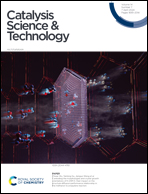Substrate scope driven optimization of an encapsulated hydroformylation catalyst†
Abstract
Caged complexes can provide impressive selective catalysts. Due to the complex shapes of such caged catalysts, however, the level of selectivity control of a single substrate cannot be extrapolated to other substrates. Herein, the substrate scope using 41 terminal alkene substrates is investigated in the hydroformylation reaction with an encapsulated rhodium catalyst [Rh(H)(CO)3(P(mPy3(ZnTPP)3))] (CAT1). For all substrates, the amount of branched products formed was higher with CAT1 than with the unencapsulated reference catalyst [Rh(H)(CO)2(P(mPy3))2] (CAT2) (linear/branched ratio between 2.14 and 0.12 for CAT1 and linear/branched ratio between 6.22 and 0.59 for CAT2). Interestingly, the level of cage induced selectivity depends strongly on the substrate structure that is converted. Analysis of the substrate scope combined with DFT calculations suggests that noncovalent interactions between the substrate moieties and cage walls play a key role in controlling the regioselectivity. Consequently, these supramolecular interactions were further optimized by replacing the ZnTPP building block with a zinc porphyrin analog that contained OiPr substituents on the meta position of the aryl rings. The resulting caged catalyst, CAT4, converted substrates with even higher branched selectivity.



 Please wait while we load your content...
Please wait while we load your content...